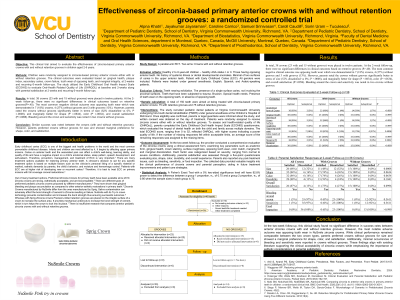Restorative
27 - Effectiveness of zirconia-based primary anterior crowns with and without retention grooves: a randomized controlled trial


Alpna Khatri, DMD (she/her/hers)
Pediatric Dental Resident
Virginia Commonwealth University, Richmond, VA
Virginia Commonwealth University, Richmond, VA
Arlington, Virginia, United States- TW
Tiffany Williams, DDS, MSD
Program Director, Pediatric Dental Residency
Virginia Commonwealth University School of Dentistry, Department of Pediatrics
Richmond, Virginia, United States
Presenting Author(s)
Program Director(s)
Effectiveness of Zirconia-Based Primary Anterior Crowns With and Without Retention Grooves: A Randomized Controlled Trial
Khatri A, Carrico C, Srinivasan S*, Jayaraman J
Virginia Commonwealth University, Richmond, VA
*McGill University, Montreal, Quebec, Canada
Purpose: This clinical trial aimed to evaluate the effectiveness of zirconia-based primary anterior crowns with and without retention grooves in children aged 2-6 years.
Methods: Children were randomly assigned to zirconia-based primary anterior crowns either with or without retention grooves. The clinical and radiographic outcomes were evaluated based on gingival health, plaque index, secondary caries, crown failure, tooth wear of opposing teeth, marginal integrity, periodontal pathology, PDL widening, and internal and external root resorption at 2-weeks and recurring 6-month follow-ups. The study utilized the Early Childhood Oral Health Impact Scale (ECOHIS) to evaluate Oral-Health Related Quality of Life (OHRQOL) at baseline and 2-weeks along with parental satisfaction at 2 weeks and recurring 6-month follow-ups.
Results: In total, 38 crowns (23 with and 15 without grooves) were placed in twelve patients. At the 2-week follow-up, there were no significant differences in clinical outcomes based on retentive grooves(P>.40). The most common negative clinical outcome was opposing tooth wear which was demonstrated in 7 (18%) crowns, 4 (27%) without grooves and 3 with grooves (13%). However, parents rated the crowns without grooves significantly better in terms of size (52% dissatisfied vs 0%; P =.0008), and marginally better for shape (P =.0634), color (P =.0634), and overall satisfaction (P=.0996). Bleeding around the crown and sensitivity was noted in two crowns without grooves.
Conclusion: Similar success was noted between the crowns (with and without retentive grooves). However, parents preferred crowns without grooves for size and showed marginal preference for shape, color, and satisfaction.
Identify Supporting Agency and Grant Number: HM20028419

.jpg)